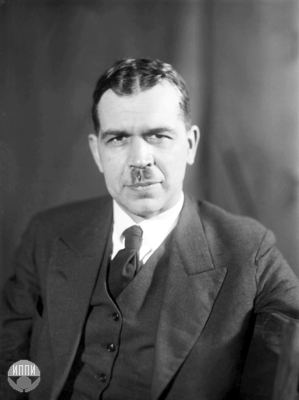Nationality Russian, Soviet Siblings Nikolai Vavilov | Name Sergey Vavilov Fields Physics, Optics Role Physicist | |
 | ||
Born 24 March 1891
Moscow, Russian Empire ( 1891-03-24 ) Alma mater Moscow State University Known for Vavilov-Cherenkov effect Died January 25, 1951, Moscow, Russia Books The Human Eye and the Sun: Hot and Cold Light Similar People Nikolai Vavilov, Pavel Cherenkov, Pyotr Lebedev, Ilya Frank, Igor Tamm | ||
Education Moscow State University Doctoral students Pavel Cherenkov | ||
Sergey Ivanovich Vavilov (Russian: Серге́й Ива́нович Вави́лов (24 March [O.S. 12 March] 1891 – January 25, 1951) was a Soviet physicist, the President of the USSR Academy of Sciences from July 1945 until his death. His elder brother Nikolai Vavilov was a famous Russian geneticist.
Contents
Biography
Vavilov founded the Soviet school of physical optics, known by his works in luminescence. In 1934 he co-discovered the Vavilov-Cherenkov effect, a discovery for which Pavel Cherenkov was awarded a Nobel Prize in Physics in 1958. The Kasha–Vavilov rule of luminescence quantum yields is also named for him.
He was a member of the USSR Academy of Sciences from 1932, Head of the Lebedev Institute of Physics (since 1934), a chief editor of the Great Soviet Encyclopedia, a member of the Supreme Soviet from 1946 and a recipient of four Stalin Prizes (1943, 1946, 1951, 1952).
He wrote on the lives and works of great thinkers, such as Lucretius, Galileo Galilei, Isaac Newton, Mikhail Lomonosov, Michael Faraday, and Pyotr Lebedev, among others.
Legacy
A meteorological station (as well as a glacier and an ice cap) in October Revolution Island, in the Severnaya Zemlya group have been named after Vavilov. A minor planet 2862 Vavilov discovered in 1977 by Soviet astronomer Nikolai Stepanovich Chernykh is named after him and his brother Nikolai Ivanovich Vavilov. The crater Vavilov on the far side of the Moon is also named after him and his brother.
There is a ship named after him, the Akademik Sergey Vavilov. She is a research vessel that can carry approximately 150 crew and passengers, and is a Class-1A icebreaker which regularly makes trips to Antarctica and the Arctic. In the summer of 2010 she was working in and around the coast of Svalbard.
